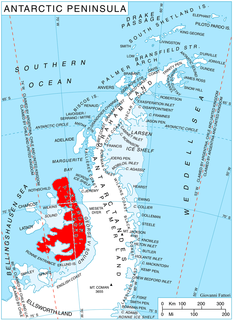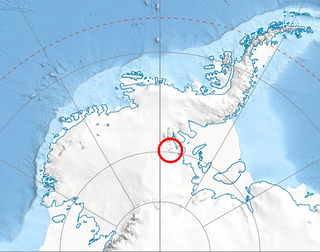Wilson Bluff is a large, rather flat-topped rock outcrop at the south end of Lambert Glacier, 16 nautical miles (30 km) west-northwest of Mount Borland. This feature is 5 sq. mi in area and has a tail of moraine extending northeast for several miles. Plotted from air photos taken by ANARE in 1956 and visited by an airborne field party led by G.A. Knuckey in October 1958. Named by Antarctic Names Committee of Australia (ANCA) for Flight Lieutenant H.O. Wilson, RAAF, pilot at Mawson Station in 1958.
Woodbury Glacier is a glacier just west of Montgolfier Glacier, flowing into Piccard Cove, Wilhelmina Bay, on the west coast of Graham Land. Mapped by the Falkland Islands Dependencies Survey (FIDS) from air photos taken by Hunting Aerosurveys Ltd. in 1956-57. Named by the United Kingdom Antarctic Place-Names Committee (UK-APC) in 1960 for Walter B. Woodbury (1834–1885), English pioneer of photomechanical printing in 1865 and of serial film cameras for use in balloons and kites in 1877.

Anthony Glacier is a glacier which flows in an east-southeast direction to the east coast of Palmer Land where it terminates opposite the south tip of Hearst Island. The upper part of this glacier was seen by a sledge party of the British Graham Land Expedition under John Riddoch Rymill in 1936–37. The glacier was seen from the seaward side in 1940 by a sledging party from the East Base of the United States Antarctic Service, and in 1947 was photographed from the air by the Ronne Antarctic Research Expedition (RARE). It was named by Finn Ronne for Alexander Anthony of the J.P. Stevens Company, New York City, which contributed windproof clothing to the RARE.

Aphrodite Glacier is a glacier 15 nautical miles (28 km) long flowing north to the east coast of the Antarctic Peninsula 3 nautical miles (6 km) west of Victory Nunatak.
Vivaldi Glacier is a glacier lying between the Colbert Mountains and the Lully Foothills, flowing south from Purcell Snowfield into the head of Schubert Inlet on the west coast of Alexander Island, Antarctica. The feature appears to be first shown on maps of the United States Antarctic Service (USAS) which photographed Alexander Island from the air in 1940. It was mapped from air photos obtained by the Ronne Antarctic Research Expedition in 1947–48, by Searle of the Falkland Islands Dependencies Survey in 1960. Named "Vivaldi Gap" by the United Kingdom Antarctic Place-Names Committee in 1961, after Antonio Vivaldi (1678–1741), Venetian composer. The name was amended to Vivaldi Glacier following review of Landsat program imagery, 1979, displaying flow lines in the feature.

Cornwall Glacier is a glacier 9 nautical miles (17 km) long, flowing south from Crossover Pass in the Shackleton Range to join Recovery Glacier east of Ram Bow Bluff. It was first mapped in 1957 by the Commonwealth Trans-Antarctic Expedition, and named for General Sir James Handyside Marshall-Cornwall, a member of the Committee of Management of the Commonwealth Trans-Antarctic Expedition, 1955–58.

Coulter Glacier is a steeply inclined glacier, 5 nautical miles (9 km) long, flowing south from the Havre Mountains, northern Alexander Island, into Kolokita Cove in Lazarev Bay, Antarctica. The glacier was photographed from the air by the Ronne Antarctic Research Expedition in 1947 and mapped from the photographs by the Falkland Islands Dependencies Survey in 1960. It was named by the Advisory Committee on Antarctic Names for R.W. Coulter, Master of USNS Alatna during U.S. Navy Operation Deepfreeze, 1969.
The Juno Peaks are two steep-sided nunataks with a small rock to the west, forming part of an east-west ridge 6 nautical miles (11 km) southwest of Mimas Peak, lying near the head of Saturn Glacier in southern Alexander Island, Antarctica. They were mapped from trimetrogon air photography taken by the Ronne Antarctic Research Expedition, 1947–48, and from survey by the Falkland Islands Dependencies Survey, 1948–50. The nunataks were named by the UK Antarctic Place-Names Committee after Juno, one of the asteroids lying between the orbits of the planets Mars and Jupiter.
The Kyle Nunataks are three nunataks 2.5 nautical miles (5 km) east of Mount Hampson, in the northern part of the Tula Mountains in Enderby Land, Antarctica. They were plotted from air photos taken from Australian National Antarctic Research Expeditions aircraft in 1956, and were named by the Antarctic Names Committee of Australia for J.T. Kyle, a member of the crew of the Discovery during the British Australian New Zealand Antarctic Research Expedition, 1929–31.
Tumble Glacier is a glacier extending along the east side of Alexander Island, Antarctica, 7 nautical miles (13 km) long and 3 nautical miles (6 km) wide, which flows east from the cliffs of Mount Egbert, Mount Ethelwulf and Mount Ethelred of the Douglas Range into the west side of the George VI Ice Shelf that occupies George VI Sound immediately south of Mount King. The glacier was first roughly surveyed in 1936 by the British Graham Land Expedition under Rymill. Resurveyed in 1948 by the Falkland Islands Dependencies Survey, and so named by them because of the extremely broken condition of the lower reaches of the glacier.
Mount Guernsey is an isolated, mainly ice-covered mountain, 1,250 metres (4,100 ft) high, standing 6 nautical miles (11 km) north of the summit of Mount Edgell, on the west coast of the Antarctic Peninsula. The name "Ile Guernesey" was given in 1909 by the French Antarctic Expedition under Jean-Baptiste Charcot, after the island of Guernsey off the coast of France. The position of "Ile Guernesey" on the French expedition maps does not agree with that of the mountain described above, but from the narrative and sketches by Maurice Bongrain, the expedition surveyor, it has been determined that this mountain was the feature seen in 1909 by Charcot from a position near the center of the entrance to Marguerite Bay. The mountain was surveyed in 1936 by the British Graham Land Expedition, but no name was assigned. It was further surveyed by the Falkland Islands Dependencies Survey in 1948.
Eckman Bluff is an angular bluff, mostly ice covered but with a steep southeast rock face, rising to about 350 metres (1,150 ft) in the southern part of the Jones Bluffs, Bear Peninsula, on the Walgreen Coast of Marie Byrd Land. It was mapped by the United States Geological Survey from surveys and from U.S. Navy aerial photographs taken 1966. It was named by the Advisory Committee on Antarctic Names after Commander James F. Eckman, Engineer Officer on the USCGC Burton Island, 1970–71; ; Ship Operations Officer on the staff of the Commander, Naval Support Force, Antarctica, 1977–78 and 1978–79.
Gould Glacier is a glacier, 12 miles (19 km) long, on the east coast of Graham Land, Antarctica, flowing south-east into Mill Inlet, to the west of Aagaard Glacier. It was first surveyed by the Falklands Islands Dependencies Survey in 1946–47, and named "East Gould Glacier". Together with "West Gould Glacier" it was reported to fill a transverse depression across Graham Land, but further survey in 1957 showed that there is no close topographical alignment between the two. The name Gould Glacier, after Rupert T. Gould, a British polar historian and cartographer, is now only applied to this glacier, and the west glacier is now called Erskine Glacier.

Mikkelsen Harbor is a small bay indenting the south side of Trinity Island between Skottsberg Point and Borge Point, in the Palmer Archipelago, Antarctica. It was discovered by the Swedish Antarctic Expedition, 1901–04. The origin of the name comes from Peder Michelsen, whaling manager who was lost in the whaling grounds in December 1910. The harbour was charted by Captain Hans Borge. Apparently the name was in common usage by 1913, at the time of the geologic reconnaissance by Scottish geologist David Ferguson in the whale-catcher Hanka.
Hariot Glacier is a glacier flowing northwest along the south side of Morgan Upland before turning west into the northern portion of the Wordie Ice Shelf, along the west coast of the Antarctic Peninsula. It was roughly surveyed by the British Graham Land Expedition, 1936–37, and the upper reaches were photographed from the air by the Ronne Antarctic Research Expedition, 1947. The glacier was surveyed from the ground by members of the Falkland Islands Dependencies Survey who travelled along it in December 1958, and it was named by the UK Antarctic Place-Names Committee after Thomas Hariot, an English mathematician who pioneered new methods of navigation under the patronage of Sir Walter Raleigh.

Henderson Glacier is a glacier about 7 nautical miles long in the Enterprise Hills of the Heritage Range, Antarctica. It flows northeast from Schoeck Peak and Hoinkes Peak to enter Union Glacier just east of Mount Rossman. Henderson Glacier was mapped by the United States Geological Survey from surveys and U.S. Navy air photos 1961–66, and was named by the Advisory Committee on Antarctic Names for Felix E. Henderson, a United States Antarctic Research Program meteorologist at Eights Station in 1965.
Mackellar Glacier is a large tributary glacier in the Queen Alexandra Range, Antarctica, flowing north along the east side of Hampton Ridge from Mount Mackellar, to enter Lennox-King Glacier. It was named by the New Zealand Geological Survey Antarctic Expedition (1961–62) in association with Mount Mackellar.

Mount Sanderson is a mountain rising to about 2,300 m in south Rouen Mountains, situated in the northern portion of Alexander Island, Antarctica. It is situated 22.5 km east of Breze Peak in Havre Mountains. The mountain was first surveyed by the British Antarctic Survey in 1975-76. Named by United Kingdom Antarctic Place-Names Committee in 1980 after Timothy John Oliver Sanderson, glaciologist who was a member of the British Antarctic Survey during 1975–78, he worked on the George VI Ice Shelf.
Hospital Point is a point formed by an ice cliff with a small amount of rock exposed at its base, lying at the north side of Yankee Harbour immediately east of Glacier Bluff, Greenwich Island, in the South Shetland Islands. It was charted and named "Rocky Point" by Discovery Investigations personnel on the Discovery II in 1935. In order to avoid duplication the UK Antarctic Place-Names Committee rejected this name in 1961 and substituted a new one. Hospital Point derives from "Hospital Cove", a name for Yankee Harbour in common use among British sealers in the 1820s and British whalers in the 1920s.
Richardson Bluff is a steep rock bluff which rises on the east side of Kirkby Glacier opposite Frecker Ridge, in the Anare Mountains, Victoria Land. Named by ANARE for Sgt. A. Richardson, RAAF, member of the RAAF Antarctic Flight which accompanied the ANARE cruise to this coast, 1962.







